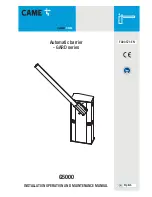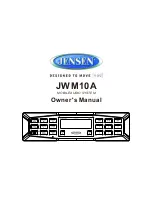
32
Encoder
- It is unnecessary to define any decoder types when using Comrex codecs because they automatically
adapt to the incoming stream. Using this menu, users can select the encoder used to send audio from this BRIC-
Link (local) as well as the encoder used to send audio to this BRIC-Link (remote). The default value of the remote
encoder is to follow the local encoder (i.e., it will send exactly the same codec mode it receives). This is defined as
Follow Mode in the remote encoder selection table. See the
About the Algorithms
section on
Page 68
for more
information on selecting encoders.
Transmit On/Off
- This option determines whether the selected encoder (local or remote) is actually sending
any data. By default, Transmission and Reception on all encoders is turned on, but there may be circumstances
where one-way operation is desired (e.g.
Multistreaming
, as described on
Page 71
). Turning off the local encoder
transmission disables
outgoing
audio, and disabling the remote encoder transmission disables
incoming
audio.
ADVANCED LOCAL & REMOTE OPTIONS
The following advanced options apply to both the
local and remote entries, and largely deal with the performance
of
Jitter Buffer Manager
. This is actually a very complex decision-making process involving many variables, and
most of the time the default parameters should work well. These advanced options are a means of overriding these
defaults, and Comrex recommends that users take care when changing them. Note that when it comes to settings
that effect the jitter buffer manager, local settings affect the decoder on the local side, and remote settings affect
the decoder on the remote end
.
Frames per Packet
- This function allows the encoder to wait for variable “
X
” number of frames to exist before
sending a packet. This option differs from FEC because each frame is only sent once. Setting this value to a number
higher than one can reduce network usage, at the expense of delay. This is because packet overhead bits like IP and
UDP headers are sent less often.
Decoder Downmix
- This option controls the method by which decoded stereo audio will be down-mixed to mono
.
Loss Cushion
- Packets may arrive at the decoder displaying a range of statistical properties. They may arrive in
reasonably good timing and in order, or half may arrive quickly with the other half delayed significantly. In some
cases, most of the packets arrive in a timely manner, but a small percentage of them may be extremely late. It is
usually preferable to allow these late packets to be left out of the stream entirely and keep the delay lower. The
decoder error concealment hides these packet losses. The
Loss Cushion
parameter instructs the buffer manager
to ignore a certain percentage of late packets in its calculation. The default value is 5%. Applications that are not
delay-sensitive may wish to reduce this value to zero, while extremely delay-sensitive applications may prefer to
have this closer to 25%.
Retransmit Squelch Trigger
- Retransmit Squelch options are used to determine how the buffer manager reacts
to typical data dropouts like those seen on wireless networks. The Trigger option determines the amount of time
the decoder must experience 100% packet loss before the Retransmit Squelch function is triggered. Default is one
second.
Retransmit Squelch Max
- The longest period of data loss during which the squelch function is active. Default is two
seconds). During the squelch period, the buffer manager ignores the relative jitter experienced and does not adjust
Содержание BRIC-Link
Страница 1: ...Product Manual ...
Страница 23: ...23 Figure 10 network recovery mode ...
















































